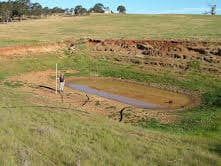VICTORIAN livestock producers are being urged to identify safe areas as part of their farm and livestock bushfire plans.
Department of Economic Development, Jobs, Transport and Resources is urging all livestock owners to be well prepared and plan for the possibility of a fire emergency on their farm.
Victoria’s Chief Veterinary Officer Charles Milne said a key factor in minimising the risk to livestock during a bush fire or on extreme fire danger days, is to identify safer areas on the farm where livestock can be moved.
“The area you choose will depend on the type of livestock you are farming and their expected behaviour during a fire.
“Other factors to consider include the terrain and accessibility of the area as well as the behaviour of the fire itself,” Dr Milne said.
“Having a livestock fire plan that has been carefully thought through and can be quickly executed will minimise the risk to stock and people, especially if that plan has been practiced prior to an event.”
Having a firebreak of some sort is imperative, using bare laneways and ploughed breaks can be effective, as can heavily grazed paddocks with low-level vegetation.
He said low risk areas should not be next to areas of scrub or bushland and should be large enough to allow livestock to move away from a fire.
“All low risk areas should have sufficient drinking water to enable stock to remain in the area for extended periods of high fire risk and high temperatures, be protected by firebreaks and be free of leaf, twigs and bark build-up.
“Areas where there are dams and swamps are also safer.”
Dr Milne said stockyards have been known to successfully hold stock during a fire if protected by a firebreak.
“If this is your preferred option, consider using a sprinkler system as if stock are held together on a hot day, they can suffer heat stress.”
Horses should not be locked up in small areas or stables, but moved to an open paddock with minimal vegetation so they can move freely.
Dr Milne said horses are good at moving themselves to safe open areas and usually suffer minimal burns if left to do so.
“If equipment such as rugs, halters and flyveils remain on horses, the plastic may melt and metal buckles can burn the animal.
“Consider using rope halters for easier handling and management,” he said.
Dr Milne said it was crucial not to open gates that may allow stock access to public roadways, as they will be a hazard to traffic in smoky conditions.
“If you intend to relocate your horse to a safer property, ensure that this is done early in the day before a fire threatens, or ideally the day before.
“On days of extreme fire danger or ideally the day before, stock should be moved into lower risk areas.”
Livestock producers should aim to act early and not get caught trying to move stock as a fire approaches.
“Listen to weather forecasts and observe your own environment to help you decide when to put your plan into action,” Dr Milne said.
For further assistance on preparing a farm and livestock bushfire plan go to www.agriculture.vic.gov.au/animalemergency or contact the DEDJTR Customer Service Centre on 136 186.
Source: DEDJTR


HAVE YOUR SAY